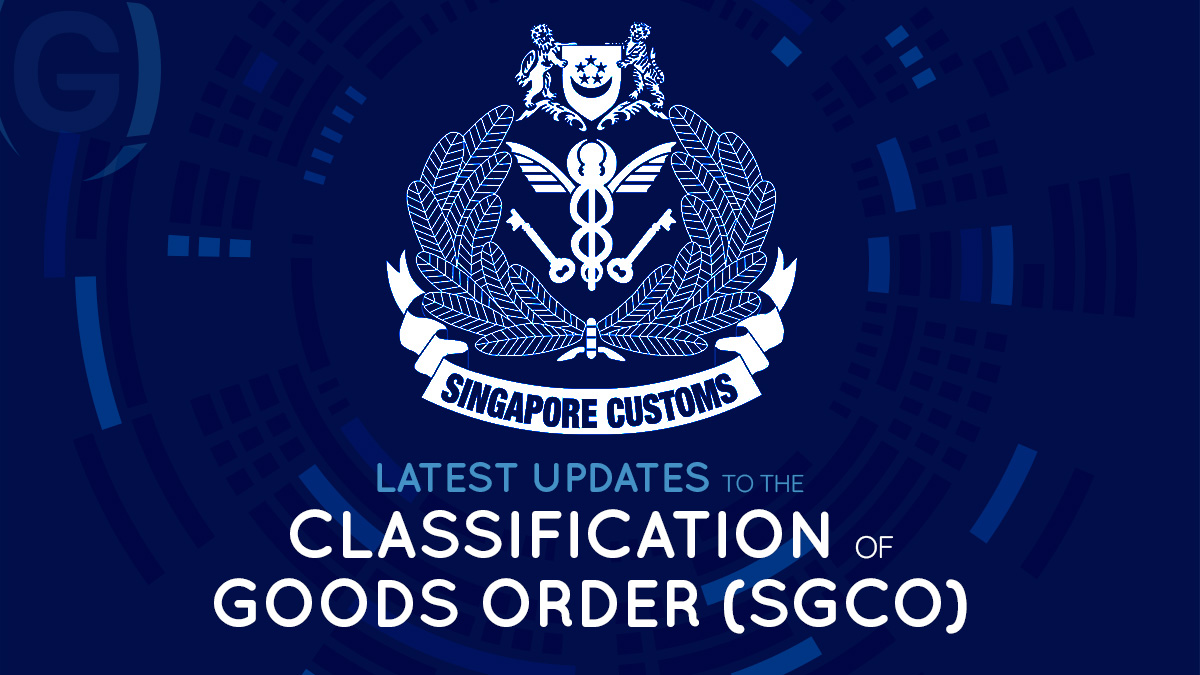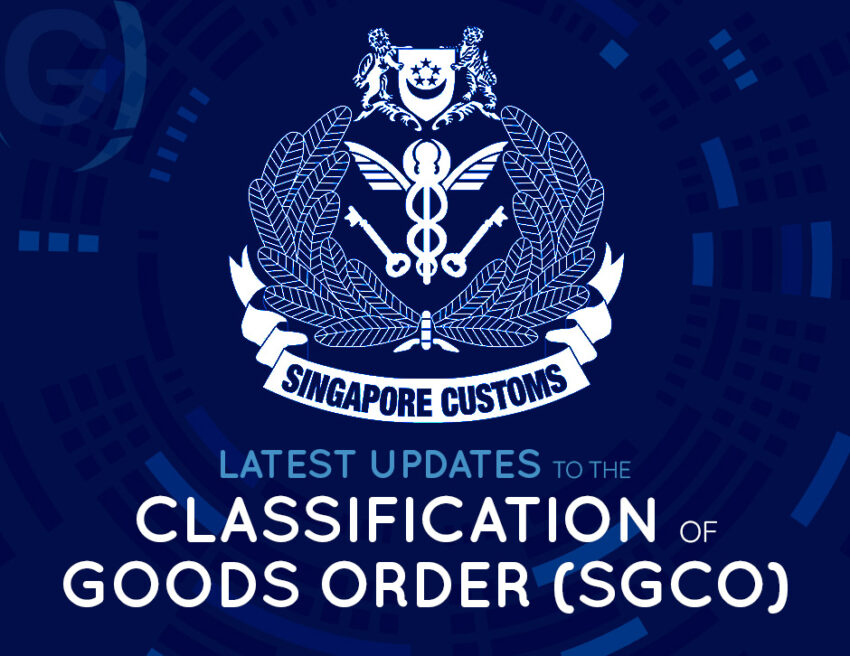Positioned at the crossroads of major global shipping routes, Singapore serves as a critical gateway between Asia and the rest of the world, facilitating the seamless flow of goods. Its deep-sea port, consistently ranked among the busiest in the world, offers unparalleled connectivity and access to over 600 ports globally. Moreover, Singapore’s appeal as a logistics hub, attracting multinational corporations to use its facilities as a distribution center for the Asia-Pacific region and beyond. On August 1, 2024, Singapore Customs announced significant updates to the Singapore Customs Classification of Goods Order (SGCO), which will take effect on October 1, 2024. These changes have critical implications for cargo owners, distributors, and logistics providers. In this blog, we’ll outline the key updates, how they affect various stakeholders, and the main differences between the SGCO 2023 and SGCO 2024.

How The Singapore Customs Updates Will Affect the Logistics Industry
For Cargo Owners and Distributors
Cargo owners and distributors are responsible for ensuring that the goods you export, re-export, trans-ship, or transit are correctly classified and declared using the relevant product codes as defined in the SGCO. Additionally, failure to comply can result in legal consequences, and therefore this responsibility cannot be outsourced.
For Logistics Providers
Freight forwarding companies can have a contractual obligation to ensure that their clients’ goods are classified correctly and declared according to the relevant SGCO product codes for export, re-export, or trans-shipment. Therefore, ensuring accuracy in these classifications is essential to avoid potential compliance issues.
Note: It is crucial to understand that the SGCO Product and HS Code are not the same and should not be confused.
Summary of Changes Between SGCO 2023 and SGCO 2024
The SGCO updates involve changes to the Military List (ML) and the Dual-Use List. Here’s a summary of the main changes:
Changes to Items on the Military List (ML)
- ML1 (Special Materials): Updated technical specifications for materials used in defense applications.
- ML2 (Materials Processing): Revised controls on processing equipment for military-grade materials.
- ML3 (Electronics): Adjusted criteria for military electronics, including integrated circuits and microwave devices.
- ML4 (Computers): Modified performance benchmarks for military computers.
- ML5 (Telecommunications and Information Security): Refined controls on military communication and cryptographic systems.
- ML6 (Sensors and Lasers):
- Added details on deformable mirrors and their technical characteristics.
- Updated thresholds for lasers, including increased output power requirements and specific characteristics for semiconductor lasers.
- ML7 (Navigation and Avionics): Clarified types and characteristics of inertial measurement systems and expanded notes on source code and technology.
- ML8 (Marine Systems): Revised terminology and specifications for marine propulsion systems and unmanned submersible vehicles.
- ML9 (Aerospace and Propulsion):
- Removed certain performance criteria for gas turbine engines.
- Expanded descriptions for assemblies and components with new technology requirements.
- Updated notes on launch support equipment and technology for specific aerospace components.
Changes to Items on the Dual-Use List
- Category 1 (Special Materials and Related Equipment)
- 1A001 (Components for Composite Structures): Updated technical specifications and performance thresholds.
- Category 2 (Materials Processing)
- 2B001 (Machine Tools): Revised criteria for precision and capabilities of machine tools.
- Category 3 (Electronics)
- 3A001 (Electronic Components): Adjusted parameters for electronic components, including integrated circuits and microwave devices.
- Category 4 (Computers)
- 4A001 (High-Performance Computers): Updated performance benchmarks and technical specifications for controlled computers.
- Category 5 (Telecommunications and Information Security)
- 5A002 (Information Security): Refined controls on cryptographic equipment and software, with updated encryption strength thresholds.
- Category 6 (Sensors and Lasers)
- 6A004 (Deformable Mirrors): Added detailed technical notes on adaptive optic mirrors.
- 6A005 (Lasers): Increased threshold for non-tunable pulsed lasers and expanded criteria for semiconductor lasers.
- 6B007 (Gravity Meters): Specified static accuracy requirements.
- 6C005 (Laser Materials): Added specific measurement criteria for core numerical aperture.
- Category 7 (Navigation and Avionics)
- 7A003 (Inertial Measurement Equipment): Added technical notes clarifying characteristics and types of inertial measurement systems.
- 7D004 (Source Code): Expanded note to include common computer elements and utilities.
- 7E004 (Other Technology): Clarified exclusions for common computer elements and utilities.
- Category 8 (Marine)
- 8A001 (Submersible Vehicles): Specified unmanned submersible vehicles require a wireless optical data or command link exceeding 1,000 meters.
- 8A002 (Marine Systems): Changed terminology from “engines” to “motors” and included rim-driven propulsion systems.
- Category 9 (Aerospace and Propulsion)
- 9A001 (Aero Gas Turbine Engines): Removed specification for engines designed to cruise at Mach 1 or higher for over 30 minutes.
- 9A003 (Aero Gas Turbine Engines Assemblies): Included assemblies or components with technologies specified in 9E003.k.
- 9A115 (Launch Support Equipment): Added notes specifying apparatus and devices installed on manned aircraft or UAVs.
- 9E001 (Development Technology): Removed reference to 9A001.b., focusing on specified equipment and software.
- 9E002 (Production Technology): Removed reference to 9A001.b., focusing on specified equipment.
- 9E003 (Other Technology): Added subcategory 9E003.k. detailing technology for specific aero gas turbine engine components and systems, with technical notes.
- 9E101 (Development Technology): Consolidated description for technology development of specified goods in various subcategories.
Conclusion
The updates to the SGCO reflect Singapore Customs’ ongoing efforts to align with international standards and address emerging technologies. Cargo owners, distributors, and logistics providers must familiarize themselves with these changes to ensure compliance and avoid potential legal issues. By understanding the new classifications and requirements, stakeholders can better navigate the complexities of international trade and secure their operations within the updated regulatory framework.


